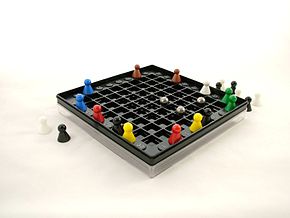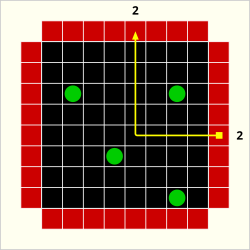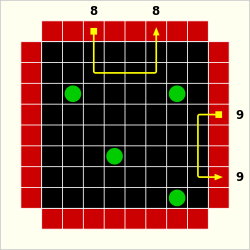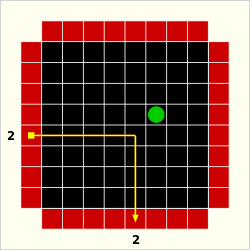93:
are hidden by a person in a two-player game. In a solitaire game, they are either hidden by a computer or they are pre-hidden; in this case, the results of various probes are resolved by looking them up in a book. The seeker designates where the ray enters the black box and the hider (or computer or book) announces the result (a "hit", "reflection", or "detour"/"miss"). This result is marked by the seeker, who uses these to deduce the position of the atoms in the black box.
302:
284:
256:
246:
236:
226:
216:
197:
182:
167:
148:
132:
116:
102:
22:
271:
Each entry and exit location counts as a point. Hits and reflections therefore cost one point, while detours cost two points. When the seeker guesses the location of the atoms in the grid, each misidentified atom position costs penalty points: ten in the original
Waddingtons rules, five in the Parker
297:
If the fifth atom is in any of the four positions marked by the X, no ray can ever determine where it is located, because it is shielded from all directions by the surrounding atoms. The addition of more atoms allows for more complex indeterminate configurations, but also allows for more intriguing
92:
is played on a two-dimensional grid. The object of the game is to discover the location of objects ("atoms", represented by metal balls in the
Waddingtons game and by yellow balls in the Parker Brothers version) hidden within the grid, by the use of the minimum number of probes ("rays"). The atoms
208:
Rays that do not result in hits or reflections are called "detours". These may be single or multiple deflections, or misses. A detour has an entry and an exit location, while hits and reflections only have an entry location for a hit, and a single entry/exit location for a reflection.
143:
The interaction resulting from a ray which does not actually hit an atom, but which passes directly to one side of the ball is called a "deflection". The angle of deflection for this ray/atom interaction is 90 degrees. Ray 2 is deflected by the atom at left, exiting the box as shown.
127:
Atoms interact with rays in three ways. A direct impact on an atom by a ray is a "hit". Thus, ray 1 fired into the box configuration at left strikes an atom directly, generating a "hit", designated by an "H". A ray which hits an atom does not emerge from the box.
262:
The complete set of interactions of rays with the original sample black box is shown at left. Note that for detours, the input and output locations are interchangeable - it does not matter if ray 2 below enters the box from the left side, or the top.
159:
The final type of interaction of a ray with an atom is a "reflection", designated by an "R". This occurs in two circumstances. If an atom is at the edge of the grid, any ray which is aimed into the grid directly beside it causes a reflection.
111:
There are 32 input positions in an 8×8 grid, eight each at the top, bottom, right, and left. A beam is "fired" into one of these positions and the result is used to help deduce the location of a known number of hidden atoms.
324:
feature different types of obstacles concealed in the box, which affect rays in varying ways — such as mirrors which reflect only a direct-hit ray, or prisms which split one ray into two. The
294:
is played on an 8×8 grid with five (or more) atoms. Five-atom configurations allow for positions that cannot be unambiguously determined by probes. The grid at left shows an example of this.
232:
Notice that this complex set of five deflections above looks exactly like a single deflection, as shown by ray 2 at left. Things are not always as simple as they seem within a black box.
178:
The other circumstance leading to a reflection is when two deflections cancel out. In the grid at left, ray 6 results in a reflection due to its interaction with the atoms in the grid.
242:
Reflections and hits can be more complex, too. Ray 2 gets deflected by the first atom, reflected by the next two atoms and again deflected by the original atom, yielding a reflection.
275:
Different atom positions lead to different average scores - a very easy four-ball game might average eight or nine points to solve, while a very hard game might average 18 points.
649:
108:
The most common configuration for novice players is four atoms in an 8×8 grid. At left is a sample black box in this configuration.
695:
363:. As joint winner of the competition, the game was officially licensed from Waddingtons and published (along with fellow winner
559:
459:
212:
Of course, more complex situations result when these behaviors interact. Ray 8 results in two deflections, as does ray 9.
60:, and there are numerous computer implementations for many different platforms, including one which can be run from the
512:
359:
163:
Rays 3 and 4 at left would each generate a reflection, due to the atom at the edge. Ray 5 would be a hit on the atom.
252:
Ray 3 below gets deflected by the first atom, then by the second atom, and then hits the third atom, yielding a hit.
705:
715:
710:
496:
700:
449:
720:
552:
420:
78:
434:
44:
for one or two players, which simulates shooting rays into a black box to deduce the locations of "
393:
624:
57:
614:
604:
545:
330:
321:
8:
350:
193:
There are also misses. Ray 7 at left, for instance, interacts with no atoms in the grid.
589:
74:
508:
455:
599:
385:
354:
634:
629:
53:
48:" hidden inside. It was created by Eric Solomon. The board game was published by
639:
576:
689:
654:
619:
532:
504:
346:
317:
can also be played with different-sized grids, such as 10×10 or 12×12 grids.
38:
368:
77:
who was awarded the 1979 Nobel Prize in
Medicine for his invention of the
644:
568:
64:
49:
528:
41:
669:
584:
372:
343:
664:
659:
308:
It is possible to "hide" a ball with this four-atom configuration.
301:
283:
255:
245:
235:
225:
215:
196:
181:
166:
147:
131:
115:
101:
21:
609:
537:
674:
325:
61:
45:
328:
game GFingerPoken and one section of the
Macintosh game
222:
Some rays travel a twisted course, like ray 1 at left.
353:) and submitted in the 'design a game' competition on
56:
in the late 1970s. The game can also be played with
488:- Lisp source code for GNU Emacs implementation of
687:
553:
272:Brothers version and most computer editions.
481:(instruction manual), Parker Brothers, 1978
560:
546:
342:A version of the game was created for the
495:
349:by Ben Finn (who would go on to co-write
20:
688:
447:
541:
479:Black Box: Rules and Solitaire Games
173:
13:
300:
282:
254:
244:
234:
224:
214:
195:
180:
165:
146:
130:
114:
100:
14:
732:
522:
451:Family games : The 100 best
567:
696:Board games introduced in 1977
441:
427:
413:
311:It is not ambiguous, however.
1:
406:
337:
154:
138:
84:
73:was inspired by the work of
7:
290:The most common variant of
278:
10:
737:
472:
401:Family Games: The 100 Best
378:
266:
52:from the mid-1970s and by
575:
435:"Jeux & stratégie 06"
203:
96:
706:Abstract strategy games
188:
448:Lowder, James (2010).
334:fall into this class.
305:
287:
259:
249:
239:
229:
219:
200:
185:
170:
151:
135:
122:
119:
105:
29:
716:Parker Brothers games
711:Deduction board games
499:(1982). "Black Box".
322:computer puzzle games
304:
286:
258:
248:
238:
228:
218:
199:
184:
169:
150:
134:
118:
104:
24:
615:Escape from Atlantis
394:Jeux & Stratégie
28:gameboard and pieces
421:"GAMES Magazine #8"
320:A related class of
16:Abstract board game
701:Puzzle video games
507:. pp. 30–37.
306:
288:
260:
250:
240:
230:
220:
201:
186:
171:
152:
136:
120:
106:
75:Godfrey Hounsfield
30:
721:Waddingtons games
683:
682:
505:Penguin Books Ltd
461:978-1-934547-21-2
360:The Saturday Show
331:System's Twilight
174:Double deflection
728:
562:
555:
548:
539:
538:
518:
497:Pritchard, D. B.
487:
466:
465:
445:
439:
438:
437:. December 1980.
431:
425:
424:
423:. November 1978.
417:
736:
735:
731:
730:
729:
727:
726:
725:
686:
685:
684:
679:
630:Game of Nations
571:
566:
525:
515:
485:
484:F. Thomas May,
475:
470:
469:
462:
454:. Green Ronin.
446:
442:
433:
432:
428:
419:
418:
414:
409:
381:
340:
281:
269:
206:
191:
176:
157:
141:
125:
99:
87:
54:Parker Brothers
17:
12:
11:
5:
734:
724:
723:
718:
713:
708:
703:
698:
681:
680:
678:
677:
672:
667:
662:
657:
652:
647:
642:
640:Mine a Million
637:
632:
627:
622:
617:
612:
607:
602:
597:
592:
587:
581:
579:
573:
572:
565:
564:
557:
550:
542:
536:
535:
524:
523:External links
521:
520:
519:
514:0-14-00-5682-3
513:
493:
482:
474:
471:
468:
467:
460:
440:
426:
411:
410:
408:
405:
404:
403:
398:
390:
380:
377:
339:
336:
298:interactions.
280:
277:
268:
265:
205:
202:
190:
187:
175:
172:
156:
153:
140:
137:
124:
121:
98:
95:
86:
83:
15:
9:
6:
4:
3:
2:
733:
722:
719:
717:
714:
712:
709:
707:
704:
702:
699:
697:
694:
693:
691:
676:
673:
671:
668:
666:
663:
661:
658:
656:
653:
651:
648:
646:
643:
641:
638:
636:
633:
631:
628:
626:
623:
621:
618:
616:
613:
611:
608:
606:
603:
601:
598:
596:
593:
591:
588:
586:
583:
582:
580:
578:
574:
570:
563:
558:
556:
551:
549:
544:
543:
540:
534:
533:BoardGameGeek
530:
527:
526:
516:
510:
506:
502:
498:
494:
491:
483:
480:
477:
476:
463:
457:
453:
452:
444:
436:
430:
422:
416:
412:
402:
399:
396:
395:
391:
388:
387:
383:
382:
376:
374:
370:
366:
362:
361:
356:
352:
348:
347:home computer
345:
335:
333:
332:
327:
323:
318:
316:
312:
309:
303:
299:
295:
293:
285:
276:
273:
264:
257:
253:
247:
243:
237:
233:
227:
223:
217:
213:
210:
198:
194:
183:
179:
168:
164:
161:
149:
145:
133:
129:
117:
113:
109:
103:
94:
91:
82:
80:
76:
72:
68:
66:
63:
59:
58:pen and paper
55:
51:
47:
43:
40:
36:
35:
27:
23:
19:
594:
500:
489:
478:
450:
443:
429:
415:
400:
392:
384:
369:Oliver Twins
364:
358:
341:
329:
319:
314:
313:
310:
307:
296:
291:
289:
274:
270:
261:
251:
241:
231:
221:
211:
207:
192:
177:
162:
158:
142:
126:
110:
107:
89:
88:
70:
69:
33:
32:
31:
25:
18:
590:Air Charter
569:Waddingtons
501:Brain Games
486:blackbox.el
79:CAT scanner
65:text editor
50:Waddingtons
690:Categories
407:References
338:Video game
155:Reflection
139:Deflection
42:board game
670:Travel Go
625:Formula 1
600:Buccaneer
595:Black Box
585:4000 A.D.
529:Black Box
490:Black Box
375:in 1984.
373:Acornsoft
344:BBC Micro
315:Black Box
292:Black Box
90:Black Box
85:Objective
71:Black Box
34:Black Box
26:Black Box
665:Totopoly
660:Subbuteo
635:Monopoly
351:Sibelius
279:Variants
39:abstract
605:Careers
473:Sources
379:Reviews
367:by the
267:Scoring
655:Sorry!
650:Scoop!
620:Equals
610:Cluedo
511:
492:, 1985
458:
365:Gambit
204:Detour
37:is an
675:Whot!
577:Games
386:Games
371:) by
326:GNOME
97:Rules
62:Emacs
46:atoms
645:Risk
509:ISBN
456:ISBN
189:Miss
531:on
357:'s
355:ITV
123:Hit
692::
503:.
397:#6
389:#8
81:.
67:.
561:e
554:t
547:v
517:.
464:.
Text is available under the Creative Commons Attribution-ShareAlike License. Additional terms may apply.





























